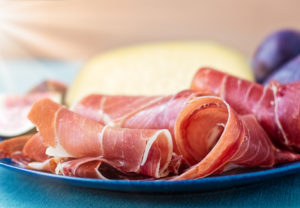Written by Allen Dawson, Meat & Poultry Market Manager
In my line of work, I use a variety of terms for describing the type of processes that our meat & poultry customers are using in their mixing operation. I’m talking about curing, marinating, and pickling. Each has a distinct meaning with regards to preserving meat, adding water to it, and/or adding flavor to the meat.
Preserving meat in a liquid substance dates as far back as the 1600’s and back then, preserving meat this way was called “curing”. Before curing came along, preserving was done by dehydrating the meat with fire. Curing was a huge step in human evolution because it provided a way to have fresh meat more often. Today, curing most often involves using a combination of sugars, nitrates and/or nitrites.

Back in the 1700’s butchers in Germany used a vein injection process to cure. They discovered that there was one specific vein that fed an entire sub-primal cut of meat. A syringe type tool forced liquid into the vein and throughout the muscle. The vein was tied off and they used their hands to massage the curing ingredients throughout the ham fully and evenly – hams made this way today are very expensive!
Another primitive but successful way to extend the shelf life of meat is to pickle it. Pickling became very popular in the South after the Civil War. Food was very scarce, and they did anything they could to extend shelf life. They used vast amounts of water, vinegar and salt to make a pickle used for soaking meat for up to two weeks at a time – I have seen up to a 2% increase in water absorption using this method! Some processors in the US still pickle items this way. Popular in the South are pickled pigs’ feet, ham hocks, turkey necks and turkey tails.
Back in the 90’s the US Meat Industry adapted the German injection concept but instead of using a vein, an injector accurately distributed marinade liquid into the entire cut of meat at once. The injector cut weeks out of curing and/or pickling meat. When meat was first injected this way, simple formulas of water, salt and sodium phosphate were used. Now, hot & spicy and other flavors are injected so all that’s really needed is to cook the meat! If you walk into any major grocery store, you’ll notice that most whole muscle items are enhanced one way or the other.
Remember that pickling adds about 2% to the weight of the meat? Deli meat, boneless turkey breast and boneless hams are highly injected – sometimes up to 60% water and ingredients are added before any further processing.
Prior to these injections, whether for meat or poultry, the ingredients need to be mixed with equipment that doesn’t add too much heat to the mixture, doesn’t break down functional ingredients, and disperses powders sufficiently so that your injectors won’t clog. Some processes might require a high shear while simpler mixtures might just need constant agitation. We can customize a solution that works for your specific application. Contact us to get started!

 Jesper Sæderup Lindeløv, Managing Director
Jesper Sæderup Lindeløv, Managing Director Knud Erik Juhl Jensen, General Manager, Admix Europe ApS
Knud Erik Juhl Jensen, General Manager, Admix Europe ApS
 Patrick Lakin, Director of Sales and Marketing
Patrick Lakin, Director of Sales and Marketing Kara Martakos, Human Resources Director
Kara Martakos, Human Resources Director Keith Cheries, Director of Sales Operations
Keith Cheries, Director of Sales Operations Eric Therriault, Vice President of Engineering
Eric Therriault, Vice President of Engineering Bob Trottier, Vice President of Operations
Bob Trottier, Vice President of Operations Dan Cameron, Chief Financial Officer
Dan Cameron, Chief Financial Officer Mike Rizzo, Chief Executive Officer
Mike Rizzo, Chief Executive Officer